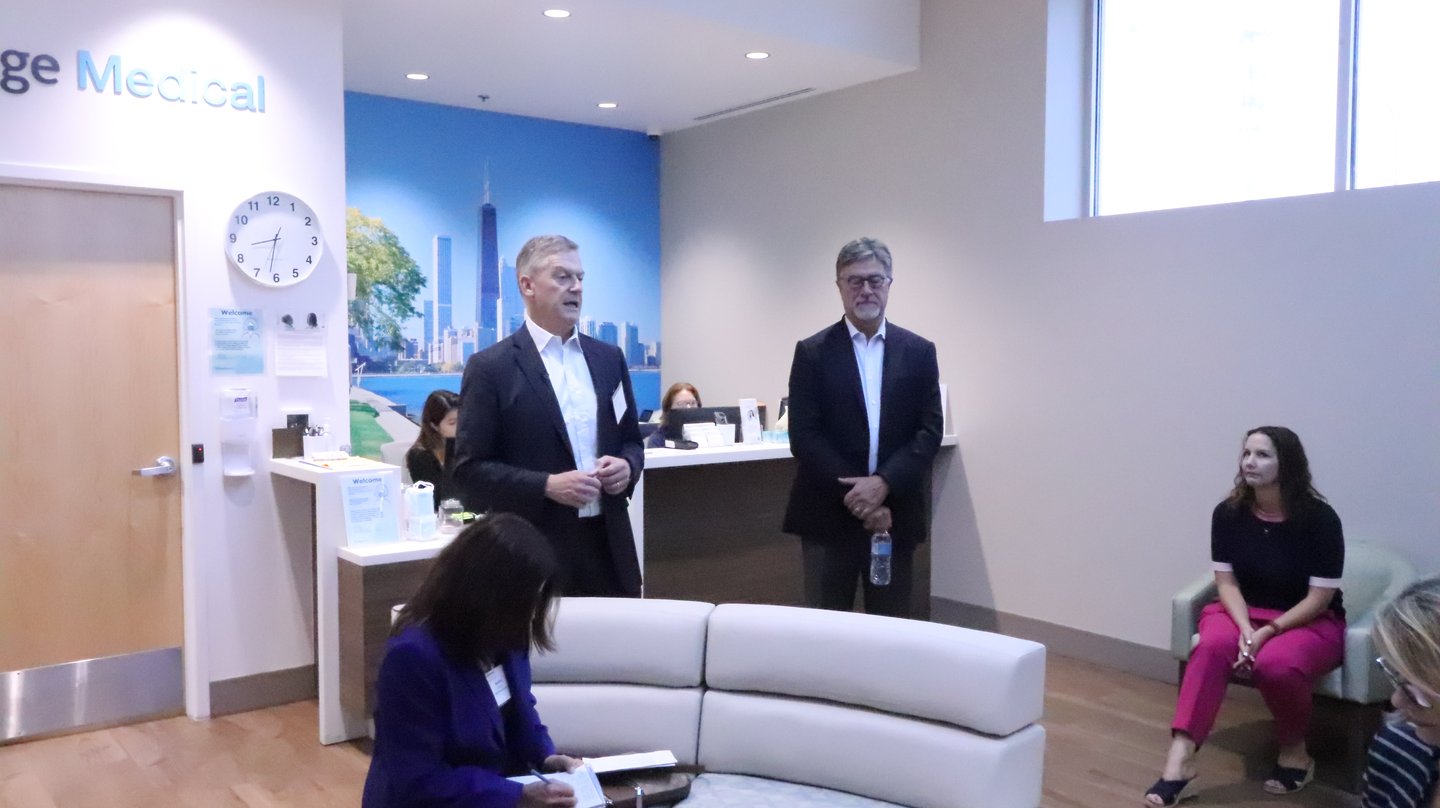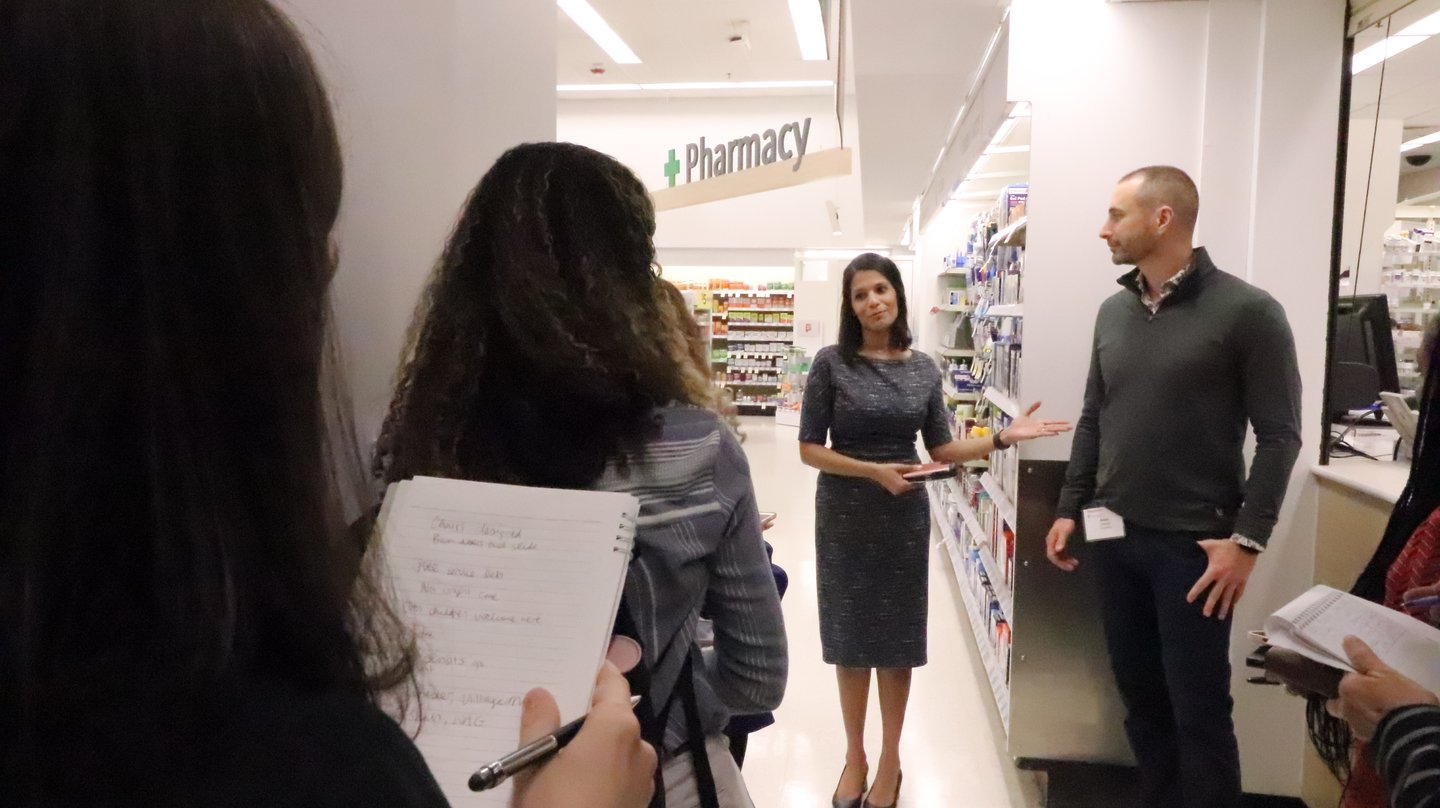What does the future of health care and pharmacy at Walgreens look like?
The first Village Medical at Walgreens co-location in Elk Grove Village, Ill., and its newest micro-fulfillment center in Bolingbrook, Ill., were on full display at a private press briefing, which included discussions about the future of health care and pharmacy by Walgreens’ top brass.
The briefing was led by John Driscoll, executive vice president and president, U.S. Healthcare, Walgreens Boots Alliance, who shared details on the vision and strategy for the U.S. Healthcare business and how Walgreens is increasing access, equity and positive outcomes for patients and local communities.
Dr. Clive Fields, co-founder and chief medical officer of VillageMD, shared how VillageMD is creating an ecosystem that optimizes efficiency and collaboration of care teams to address access and health equity and improve patient outcomes.
Rina Shah, senior vice president of Pharmacy of the Future and Transformation at Walgreens, also was present, sharing the vision for the future of pharmacy and providing a glimpse into how Walgreens continues to support the evolving pharmacist’s role.
Scott Malone, vice president of pharmacy engagement experience at Walgreens, showcased the cutting-edge automation that efficiently fills thousands of prescriptions every day and quickly gets them to Walgreens’ pharmacies.
Driscoll opened the discussion, expressing his enthusiasm about what Walgreens is doing in health care and noted the retailer's many assets.
[Read more: Retailer of the Year 2021: Walgreens seizes its omnichannel opportunity]
“We’re starting to see really good proof points around the promise of leveraging Walgreens’ traditional assets to help create a system that provides more access, more personalized care and delivers better outcomes at a lower cost,” Driscoll said, citing VillageMD as an example. "Today you can see the culture at Village, because ultimately health care is deeply personal and if you get the culture right, and I think that we have got a wonderful organization, with 200,000 pharmacists and pharm techs who are deeply focused.”
Driscoll said that in addition to Walgreens’ expansion into health care with Village, the retailer has additional assets, including Shields Specialty Pharmacy, CareCentrix and Pearl Health. “Everything we are doing is all about helping deliver a healthcare system that can deliver better outcomes at lower costs that leverages what we do. Everything we do either starts with a script, relates to a script and builds on our expertise with scripts and looks at where are the opportunities in health care where we can partner, and invest with organizations like Village and learn how to do a better job for our patients,” Driscoll said.
Emphasizing that health care is "just too hard for patients," Driscoll said, “who would engineer a system that makes it hard for consumers and their families to get the care they need? Animating Walgreens’ approach to health care is not just focusing on assets, partnerships and businesses for better outcomes at lower costs, but from a consumer perspective, we want to make it easier for patients and families to get the care they need. When we bring those three things together, our pharmacy expertise, the talent, expertise and depth of our partners and our assets and that passion to personalize and improve care for families and communities and that understanding that health care is broken and we can fix it, is what pulls all of this together.”
Clive Fields took the discussion one step further, describing the essence of the collocated Walgreens Village Medical as one that is not an acute care model but "a place where patients can receive comprehensive primary care that starts in this location and extends out of this location."
Fields emphasized that people talked about the underinvestment and devaluation of primary care for a long time. "I say this with my pharmacy colleagues in the room, the same has been said about pharmacy, that as a primary care doctor and having worked in a location where there was an independent pharmacist in the same building there was huge value that could be created when those two professionals came together to deliver care. What we’ve seen is being able to work with Walgreens on a consistent basis on outcomes is the same one the pharmacist is looking at today for prescriptions I’m writing. We’ve been able to remove some of the friction from health care."
[Read more: Walgreens expanding same-day Rx delivery]
Noting that VillageMD believes these are some of the most thoughtfully designed and accessible locations in the country that meet the needs of the communities where they are located, Fields said, “These are not all homogenous suburban communities. They can be urban, economically challenged, older or migrant. They can be all the kinds of places where we know that high value, easily accessible, comprehensive primary care can make a difference in clinical and economic outcomes of that population.”
Fields shared that while there are over 200 clinics that VillageMD has in partnership with Walgreens, in 2019, this category of healthcare delivery didn’t exist.
"In 2019 the idea of moving from an acute care retail model to a comprehensive primary care retail primary model had not been done. This is the first time. Think about what we’ve learned over the last five years, the mistakes, the progress we‘ve made and the challenges we know exist as we continue to build out this model, is not an understatement. Health care is hard and one of the things we forget is it’s really hard to be a primary care doctor and it’s really hard to be a pharmacist," he said.
Fields continued, "What we’ve done is through technology and team-based care and increased accessibility and the kinds of services that meet our patients’ needs, not just in pharmacy, but outside. If you think about at home, where a nurse practitioner is under the supervision of doctors, taking care of our most elderly and debilitated patients where we have technology and analytics helping us identify not just who was in the hospital last year, but who is likely to be in the hospital next year."
On the tour of the facility, Fields said it was designed to make the patient experience frictionless, including the following details: the waiting room has a unique and beautiful skylight; large screens in the waiting room bring information about community happenings, what doctor you’ll see and what immunizations are available; the chairs are oversized for patients that may be obese; the examining tables were designed to be low enough for people to embark on easily; the rooms are painted in soothing colors; the bathroom scales are hidden from other people’s views to protect privacy; the rooms are soundproof; and the bathroom is large to accommodate people better.
What is the future of VillageMD's partnership with Walgreens? Fields said, “We’re looking at populations that have chronic diseases and places with certain density of populations and where Walgreens has been for awhile, as well as visible and safe locations."
Driscoll added, “We’re good at figuring out where there’s demand and opportunity for us to serve in pharmacy. When we think about Village, we are a believer in Village in pretty much every community we’re in. We’re testing that in 40% of our stores that are medically underserved areas by primary care. Village fits there. We also believe that Village can service well served communities because it’s a different model. We’re testing it in every type of community that we serve. We think the integration of pharmacy and doctors, particularly in a culture of team based employed doctors that Village has creates a unique added value to build a model that can deliver better care. What is one of the many things I like about Village is they don’t pick just one population to cover and that’s better for the community and the doctors are enjoying that. That will mirror all of the communities we serve.”
Rina Shah took the discussion to the future of where pharmacy can go, stating, "It is to deliver care in a way that improves the health outcomes of the patients we serve. That requires technology investment, it requires collaboration within different models like Village and what it means for Walgreens.”
Shah noted that Adam Chesler, senior vice president of pharmacy at VillageMD, who also was present at the briefing, is incredibly important as a partner. “He allows us to be more connected to how we want pharmacy to show up. He’s able to work with Clive Fields and the team and say, 'this is what we need in the practice' and then he’s able to tell me what Walgreens needs to do to handle patients.”
Emphasizing that Walgreens' pharmacists are extremely busy caring for patients and have a high volume of prescriptions and customers to manage, Shah said, "When we think about that, it requires us to transform the entire model. We’re investing heavily into freeing the capacity of our pharmacy team members so they have the time to spend with patients. We’re busy doing the same thing over and over again, filling prescriptions and if not untethering our pharmacists to be able to provide care then we won’t be successful. Our micro-fulfillment centers is a key component of what the future will look like. We do have a lot of technology embedded in the pharmacy too. If we’re busy doing something over we won’t be successful."
Lastly, Scott Malone, vice president of pharmacy engagement experience, addressed the importance of the functions of the Micro-fulfillment center in Illinois, which opened a year ago and whose automation and utilization of robots and efficiencies have been in operation for the past four months.
"This is very much a pharmacy and not a distribution center. We are actively filling prescriptions. We follow all regulations as it relates to how to run a pharmacy. We’re making sure we are safe and compliant from a regulatory perspective, which is also customer health and wellbeing. We have 4,100 team members spread across the company there are techs and pharmacists supporting the operations out of here...the back office, data processing andtaking customer phone calls," Malone said.
Pointing out that the site serves 641 stores across Illinois, Wisconsin and Ohio, Malone said, "We are at 50,000 prescriptions per day and we have the ability to scale up to 100,000 prescriptions a day. This site has 400 team members, who are pharmacists and technicians as net new job creation for the state of Illinois."
Lastly, before taking the press on the tour of the center, Malone said, "We have 11 facilities that are operating and we’ll have 19 at full scale roughly within the next year. The opportunity we have here is reducing the tasks in the pharmacy. It allows the pharmacists time to have with patients face to face."




